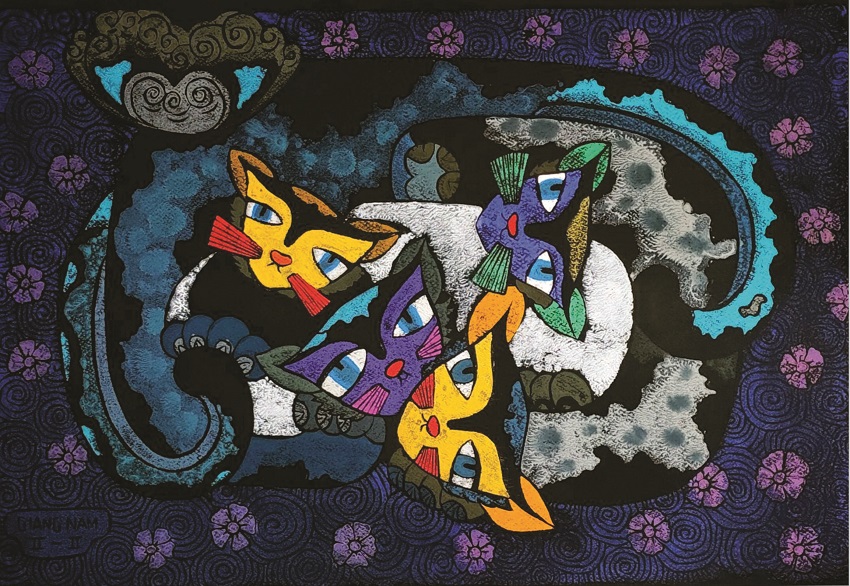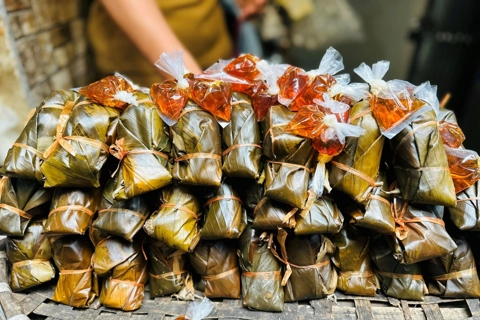Tet paintings in the home of Hanoians
A deep-rooted tradition during the Tet holiday is to hang paintings to decorate the home.
Similar to the Western custom of adorning the home with a Christmas tree and garlands to celebrate the festive season and the coming new year, Hanoians decorate their homes with kumquat trees and “Tranh Tet”, a special range of paintings used only for Tet, during the lunar new year festive season.
Tet in Vietnamese folk paintings
| The Kim Hoang folk painting "Mother of the Pig Herd" expresses hope for a happy, harmonious, prosperous Lunar New Year ahead. File photos |
This year, January 21 heralds the beginning of the most important holiday in Vietnam. Tet marks the end of the cold and harsh winter in the north and the beginning of spring. Similar to the Western new year, Tet also signifies new beginnings.
Hanging Tet paintings around the home remains a key element of traditional Tet decorations, even as society undergoes various changes.
Every spring, Tet paintings appear and add to the excitement as the new year approaches. After the day of “Ong Cong - Ong Tao”, or Kitchen God Day (falling on the 23rd day of the 12th lunar month), whether rich or poor, Vietnamese maintain the custom of shopping for a Tet painting.
It is believed that removing the old painting from last year and hanging a new one helps to say farewell to the past year and welcome a more prosperous, fortunate, and wealthy year to come.
Folk paintings were prominent in the lives of Hanoians before being replaced by modern artwork. Tet folk paintings are quite diverse in genre and contain messages of prosperity and luck. The Hang Trong, Dong Ho, and Kim Hoang folk painting schools tend to be Tet favorites.
In days gone by, homes in rural areas would be decorated with small, affordable paintings, while wealthier families in the city would hang more expensive versions. Hanging Tet paintings at home were a custom and a way to decorate the home, express wealth, and obey the Confucian rules for the family.
| The famous Dong Ho folk painting themed “Vinh hoa - Phu quy” with two little boys embracing carp, depicting happiness. |
Outside the gate, people would pin two paintings - one the God of Wealth and the other the God of Fortune - hoping to receive warm blessings. There were also families that posted paintings of the guardian gods to ward off demons and secure protection.
In the home, people often hang or pin paintings on popular topics during the Tet season, such as “Mother of the Chickens” and “Mother of the Pig Herd”, depicting folk activities in the hope of a happy, harmonious, prosperous year ahead.
The painting of “Vinh hoa - Phu quy”, with two chubby little boys embracing chickens, ducks, or carp, symbolizes happiness. The painting collection “To nu”, depicting four girls playing four different traditional musical instruments, showcases the beauty of the people.
The painting “Tu quy”, with four different trees and flowers, expresses the desire for the four seasons - spring, summer, autumn, and winter - to be filled with joyful sounds.
The “Ca chep vuot vu mon” painting, meanwhile, represents the desire among students to pass their exams, with a carp transformed into a dragon.
The “That dong” painting shows seven babies playing under a blooming peach tree, signifying the desire for a prosperous and happy life, while the “Tam đa” symbolizes happiness, fortune, and longevity.
The beginning of the new year is also the time for Vietnamese families to prepare their ancestors’ altars. A range of paintings bearing religious themes are sold on this occasion, such as those featuring the God of Wealth, the God of Fortune, the Mother Goddess, or the Four Goddesses (symbolizing Earth, Heaven, Forest and Water), while “Ngu qua” or five types of fruit paintings are also chosen to replace the one hung throughout the previous year.
| The Dong Ho painting collection of “To nu”. |
Zodiac paintings
As well as Tet paintings with their cultural, historical, and spiritual nuances, people also welcome the new year with a picture of the zodiac animal.
This year in the lunar calendar is the Year of the Cat, which, according to folk belief, symbolizes kindness, perseverance, and patience. As such, people also use the image of a terracotta cat inlaid with gold as a symbol of financial well-being. In Eastern culture, cats or rabbits ranked fourth among the 12 zodiac animals and one of the best domestic animals, including Buffalo, Dog, Horse, Goat, Chicken, Pig, and Cat.
According to Vietnamese folklore researcher Tran Quoc Thinh, the cat's patience is praised by ancient Vietnamese artists. The Dong Ho folk painting "Dam cuoi chuot” portraying a cat joining a wedding of the rat, has a profound human meaning.
“The rats (or the ordinary people), know that their security may go alongside the satisfaction and happiness of the cat (the feudal mandarin). Thus, on the occasion of their weddings, the rats decided to offer the cat their favorite food: a fish and a bird,” he said.
“The special feature of this painting is the polite attitude of the cat, sitting to receive gifts in a peaceful position, with the tail tucked forward under the buttocks, happily reaching out to accept a tribute from the rat.
This shows the ‘reconciling and noble’ attitude of the Cat, who shares happiness with rats on their special day of life,” he added.
In the line of Dong Ho folk painting, there is also a picture entitled “Baby Hugs a Cat”. Together with other paintings with the same themes of “Tranh Nhan Nghia” or “Baby Hugs a Toad”, “Tranh Le Tri” or “Baby Hugs a Turtle” and “Tranh Phu Quy or “Baby Hugs a Duck”, the zodiac painting has expressed the wit of the folk artists as well as the wishes of Vietnamese for a happy, lucky and prosperous new year.
According to folk belief, home-range animals like buffalo, roosters, ducks, and cats are symbols of happiness, prosperity, hard work, and intelligence.
| The meaningful Dong Ho folk painting entitled “Dam cuoi chuot” with a cat joining a wedding of the rat. |
The incursion of Western culture in Vietnam has put pressure on traditional folk art, and many are concerned about losing Tet paintings and an elegant pastime of Vietnamese people.
However, over the last few years, the practice of using folk paintings for home decoration during Tet has well and truly returned. Evidence of the resuscitation of this line of artwork is the annual Tet painting exhibition held by a group of 20 artists in Hanoi.
Over the last seven years, in the month leading up to Tet, the “G39” group gathers to exhibit artworks focusing on the new year’s zodiac, encouraging Tet pictures to be hung at home.
“A Spring Travel of the Cat” is a recent exhibition by G39 at Vietnam National Fine Arts Museum in Hanoi, showcasing nearly 100 cat-themed paintings to celebrate the Lunar year of the Cat, 2023.
Twenty-eight local painters and sculptors have left their imprints and personalities through the artworks created from various materials like oil on canvas, gouache, collage art, lacquer, wooden sculpture, Phu Lang, and Huong Canh potteries, among others.
“Maintaining the annual exhibition, the G39 group of artists not only honor the lunar new year but also bring art, in general, closer to the public,” said painter Le Thiet Cuong, who has promoted zodiac paintings in Hanoi since 2013. Seventy percent of the paintings in the last exhibition, he said, were sold; a good sign for Tet paintings, artists and society.
| A painting by artist Tran Giang Nam is displayed at G39 Group's exhibition to celebrate the Lunar New Year of the Cat 2023. |
















